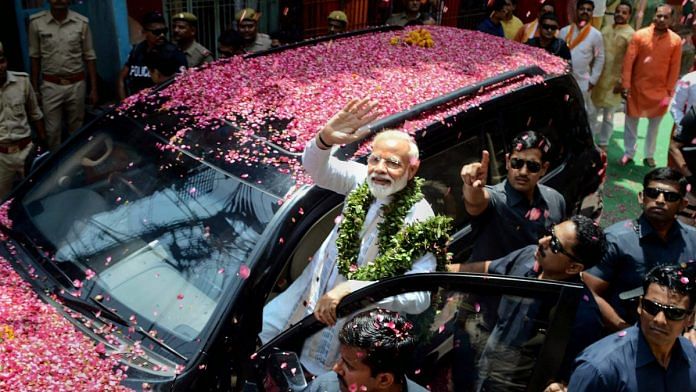They have been in a boat following Priyanka Gandhi Vadra on the Ganga. They have discussed politics with a former Miss India on board a flame-coloured bus bearing the legend ElectionExpress19. They have ridden on motorcycles to cities and villages to listen to what women have to say. They are going on train yatras to understand the mood of the nation. And they have been on helicopters with the big boys — from BJP president Amit Shah to Congress president Rahul Gandhi — to ask questions on strategy and sensibility.
Tamasha TV in the times of a tamasha prime minister?
Battered by five years of an establishment whose senior ministers often call them “presstitutes” and a social media that has become adept at labelling critics of the government anti-national, especially after the Pulwama attacks, the TV news media has now gone into an overdrive to try and construct a narrative sourced from the public.
Is there a pro-incumbency wave or an undercurrent of resentment? Will there be an endorsement of Prime Minister Narendra Modi or a backlash against him? Will the majoritarian government return with a majority or will regional leaders create an effective coalition? Beat reporters have turned into boat reporters and a lot else to go beyond the Lutyens’ Delhi narrative.
As Michiko Kakutani says in her seminal book, Death of Truth, “The post-modernist argument that all truths are partial (and a function of one’s perspective) led to the related argument that there are many legitimate ways to understand or represent an event.” This technique worked very well for supporters of Donald Trump in the 2016 presidential elections and led to a major rethink in mainstream media in the US, where journalists and commentators were wrong-footed by the assumption that Hillary Clinton would come to power.
Also read: How Modi govt did the opposite of ‘Vikas, Vikas, Vikas’ by clamping down on dissent
In India, an alternative discourse has emerged based on the growing use of social media, which, according to one estimate from Statista, is used by 326 million people as of 2018. Just as politicians have started cutting out the intermediary and are going directly to the voter, especially through WhatsApp, in this election, the media is seeking to crowdsource its political analysis.
Rajdeep Sardesai, Consulting Editor, India Today TV, who anchors a popular programme called Elections on My Plate, says, “In the studio, the attempt is to analyse. In the field, the aim is to report the sights and sounds of an Indian election. On Elections on My Plate, I tell the story of people, their concerns and then try to use food as a backdrop to take the voter on a journey that makes elections more accessible beyond just the usual netaspeak.” The diversity of cuisine on offer matches the variety of opinions, unlike the same set of talking heads on TV every night.
The generosity of ordinary people who were always ready with food; the high quality political analysis by the average voter (especially in Bihar); the gaps that still remain between high-flying rhetoric and the harsh reality of life, even in a place like Gorai, so close to south Mumbai, which is on the coast but hasn’t had drinking water for the past 30 days — for Rajdeep Sardesai, these are the abiding memories from his coverage of the 2019 Lok Sabha elections.
Away from the choreographed rallies, hired crowds and live-streamed speeches, intrepid reporters from TV channels can defy the cynicism of social media posts and the clinical nature of party slogans. Film director Ramesh Sharma, whose New Delhi Times (1986) remains one of the finest political films made in the country, believes shows by TV news reporters take the viewers to the grassroots, “capture the atmosphere, and give context”. But Sharma isn’t sure they work. “It depends on the anchors, the questions and the follow-ups. Most of the time, it becomes only an embellishment because there is so little journalism, only fluff.”
Also read: Why media ground reports, opinion & exit polls don’t agree with each other on elections
Much as studio debates have become shouting matches, generating heat, not light, the elections have moved from issues to icons to the aam aadmi and aam aurat — or, just aam. Add to that, says NewsX’s star anchor Priya Sahgal, the reporter who has become a key part of the story, and the medium becomes as important as the content itself. Conventional interviews are no longer interesting, neither is the old-fashioned campaign trail. “Perhaps, the reporters are taking a cue from the prime minister himself since he is the biggest event manager, covering the election where he plays the lead role,” Sahgal adds.
So, there are Facebook surveys, WhatsApp polls, selfies of the voting finger, prime ministerial interviews conducted in the lawns of his Lok Kalyan Marg home, or on a boat on the Ganga, and chats with Rahul Gandhi in between rallies and chopper rides. With a prime minister who has an eye for the dramatic while setting the agenda, television channels can only follow suit. Planes, trains, automobiles — TV reporters are happy to catch anything to keep pace with him.
The author is a senior journalist. Views are personal.




Journalists like Rajdeep should stop asking who is winning Modi or Rahul or Maha G. He must check about performance of the govt and then leave it to viewers to make their own judgement. It is performance that matters not otherwise
Kuchh bahut acche patrakar bhi hain. Do their jobs respectfully, firmly, hold the mike steady while asking their questions. That they will soon become the norm could be one definition of Acche Din.
Kaveree Madam, we understand, you would like to see silent journalists to a corrupt puppet government.